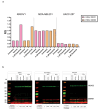Association of changes in expression of HDAC and SIRT genes after drug treatment with cancer cell line sensitivity to kinase inhibitors
- PMID: 38369747
- PMCID: PMC10878021
- DOI: 10.1080/15592294.2024.2309824
Association of changes in expression of HDAC and SIRT genes after drug treatment with cancer cell line sensitivity to kinase inhibitors
Abstract
Histone deacetylases (HDACs) and sirtuins (SIRTs) are important epigenetic regulators of cancer pathways. There is a limited understanding of how transcriptional regulation of their genes is affected by chemotherapeutic agents, and how such transcriptional changes affect tumour sensitivity to drug treatment. We investigated the concerted transcriptional response of HDAC and SIRT genes to 15 approved antitumor agents in the NCI-60 cancer cell line panel. Antitumor agents with diverse mechanisms of action induced upregulation or downregulation of multiple HDAC and SIRT genes. HDAC5 was upregulated by dasatinib and erlotinib in the majority of the cell lines. Tumour cell line sensitivity to kinase inhibitors was associated with upregulation of HDAC5, HDAC1, and several SIRT genes. We confirmed changes in HDAC and SIRT expression in independent datasets. We also experimentally validated the upregulation of HDAC5 mRNA and protein expression by dasatinib in the highly sensitive IGROV1 cell line. HDAC5 was not upregulated in the UACC-257 cell line resistant to dasatinib. The effects of cancer drug treatment on expression of HDAC and SIRT genes may influence chemosensitivity and may need to be considered during chemotherapy.
Keywords: HDAC5; Histone deacetylase; chemosensitivity; dasatinib; sirtuin.
Conflict of interest statement
No potential conflict of interest was reported by the authors.
Figures


Similar articles
-
Changes in histone deacetylase (HDAC) expression patterns and activity of HDAC inhibitors in urothelial cancers.Urol Oncol. 2013 Nov;31(8):1770-9. doi: 10.1016/j.urolonc.2012.06.015. Epub 2012 Sep 1. Urol Oncol. 2013. PMID: 22944197
-
Chronic stress and antidepressant induced changes in Hdac5 and Sirt2 affect synaptic plasticity.Eur Neuropsychopharmacol. 2015 Nov;25(11):2036-48. doi: 10.1016/j.euroneuro.2015.08.016. Epub 2015 Sep 16. Eur Neuropsychopharmacol. 2015. PMID: 26433268
-
Differential response of cancer cells to HDAC inhibitors trichostatin A and depsipeptide.Br J Cancer. 2012 Jan 3;106(1):116-25. doi: 10.1038/bjc.2011.532. Epub 2011 Dec 8. Br J Cancer. 2012. PMID: 22158273 Free PMC article.
-
Epigenetic therapy of cancer with histone deacetylase inhibitors.J Cancer Res Ther. 2014 Jul-Sep;10(3):469-78. doi: 10.4103/0973-1482.137937. J Cancer Res Ther. 2014. PMID: 25313724 Review.
-
Role of histone deacetylases and their inhibitors in cancer biology and treatment.Curr Clin Pharmacol. 2010 Aug;5(3):196-208. doi: 10.2174/157488410791498770. Curr Clin Pharmacol. 2010. PMID: 20406169 Review.
Cited by
-
Selisistat, a SIRT1 inhibitor, enhances paclitaxel activity in luminal and triple-negative breast cancer: in silico, in vitro, and in vivo studies.J Enzyme Inhib Med Chem. 2025 Dec;40(1):2458554. doi: 10.1080/14756366.2025.2458554. Epub 2025 Feb 12. J Enzyme Inhib Med Chem. 2025. PMID: 39935420 Free PMC article.
References
MeSH terms
Substances
Grants and funding
LinkOut - more resources
Full Text Sources
Other Literature Sources
Medical
Miscellaneous
